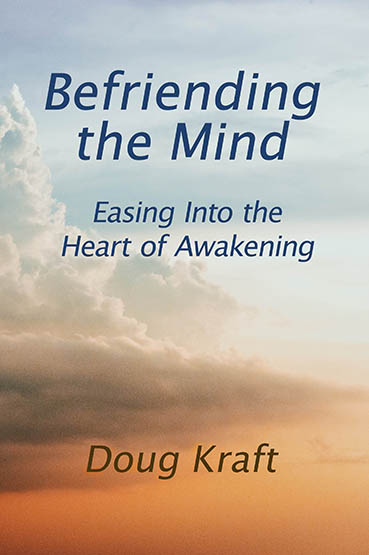
Introduction of Befriending the Mind:

I’ve seen meditators put too much of the wrong kind of effort into their practice. They think the mind needs to be controlled, disciplined, shaped, or trained. This is like trying to stand up in a hammock: it’s tiring, destabilizing, difficult to do, and completely unnecessary.
There is a natural kindness and intelligence in the mind-heart that can easily be obscured. As meditators, our job is not to get a grip on the mind but to discover the clarity and wisdom that is inherent in it. This may take effort and discipline, but wise effort seeks not to control, it seeks to reveal.
To be sure, the mind can go out of control in many ways. Sometimes the mind is like a drunken coyote howling at the moon with more enthusiasm than it knows what to do with. Sometimes it’s like a snail sliding across a large gymnasium in the dead of night not knowing where it is, where it’s going, or where to find the energy to keep moving through the gloom.
During these times we naturally yearn for a little stability, peace, vitality, clarity, or uplift. To get these, we may be tempted to take charge and will them onto the mind. However, as everyone who has broken a New Year’s resolution knows, habit is stronger than will. Willpower may work for a few hours or a few days –– but in the long run, it’s hard to sustain. And as the spiritual teacher Adyashanti puts it: “If we oppose the mind, we will be at war forever.”
Rather than trying to rule over the mind-heart, we can befriend it — open up to it with kindness, get to know it better, see how it operates.
As we befriend the mind-heart, we see that a restless mind has too much energy. It tries to burn off excess vim by howling, chattering, or running around. It wants what we want. Its heart is in the right place, but its strategy is unwise. Forcing quiet onto an over-energized mind is like yelling at a rambunctious child to sit down and shut up: the scolding agitates it even more.
On the other hand, the sluggish mind has the opposite problem: not enough energy. It has a different kind of tension that feels thick, like cold molasses. It tries to rejuvenate by slowing down and conserving energy. It wants vitality but doesn’t know where to find it. Telling it to perk up and do what needs to be done can make the situation worse by demanding more energy. Like standing in a hammock, it is tiring.
To befriend the mind-heart, we look past its stories and justifications to attend to the underlying feeling tones and textures. We can take them to heart, relate to them wisely, listen to them compassionately. We can soothe, ground, inspire, and relax. This is like settling into a hammock. The tension eases, the gloom dissipates, peace and clarity emerge.
A traditional Buddhist metaphor for this process is the parting of storm clouds –– the sun shines through and we notice the openness of the sky itself. The sun is always shining. The sky is always spacious. Clouds can obscure the luminous expansiveness, but these qualities are always present. We don’t create them. If we had to create peace, vitality, or wisdom, they would not last. Instead, we discover what was previously hidden.
This is the wisdom of the uncontrolled mind.
Uncontrolled does not mean that the mind has gone nuts. The out-of-control mind is scattered by unconscious forces, reactivity, and bad habits. On the other hand, the controlled mind is limited by our current understandings. The uncontrolled mind is neither scattered nor limited. It’s a middle way. Like the sky on a clear day, it’s calm and has limitless possibilities.
The thesis of this book is that what we truly seek is already here, though it may be obscured. Discovering our natural peace and vitality is a middle way that is neither domineering nor out of control. This path exposes a natural mind-heart that is peaceful, luminous, patient, intelligent, kind, wise, gentle, agendaless, and so quiet it does nothing to draw attention. Attuning to it could be called “easing awake.”
I have been exploring, teaching, and writing about easing awake for years. The first time I was invited to lead a nine-day retreat, I made a list of dhamma talk topics and arranged them in the order in which they were most likely to arise in a yogi’s experience. The sequence was:
In subsequent years, I wrote new talks on the same themes, using different illustrations, approaches, subtopics, and lengths of time on any given topic.
The format for these talks was lecture followed by questions and answers. This was how much of the dhamma had been transmitted to me. But I began to suspect this was not the most dynamic and effective learning style. People absorb more when they engage material deeply, actively, and experientially rather than when they just listen passively.
So I shifted from delivering monologues to presenting exercises, guided experiences, and engaged discussions. I still wanted to make the old-style lecture material available in written form because that format is helpful for some topics and for some people. Yogis who found the old style helpful could have my best thoughts in hand before, during, and after the retreat. This collection would be a kind of retreat companion.
I looked through the talks I had given over the years and chose the ones I thought were the best on each topic. As I edited them, I realized that the collection might be useful in other settings too. So I gathered them into the book you are holding. The order of chapters roughly follows my original sequence, with a few extras here and there. I split the chapters up into three sections:

A small percentage of the material in the following pages first appeared in previous books of mine and is repeated in this book for the sake of continuity and clarity.
I hope you find these writings helpful in befriending what is inherent in all of us: the luminous, spacious wisdom of the uncontrolled mind.
Copyright 2019 by Doug Kraft
This document is licensed under a Creative Commons Attribution-NonCommercial 4.0 International License. You are welcome to use all or part of it for non-commercial purposes as long as you credit the author. Specific licensing details are here.
How to cite this document
(a suggested style): "Introduction: Don’t Stand in a Hammock" by Doug Kraft, www.dougkraft.com/?p=BefriendingIntro.